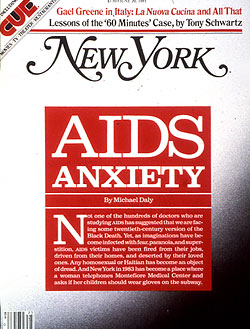 |
From the June 20, 1983 issue of New York Magazine.
On a Sunday morning last winter, model Susi Gilder flipped through a New York Times fashion supplement and came upon an advertisement that featured a friend who no longer looked like himself. The friend's name was Joe Macdonald, and once he had been one of the hottest male models in the business. Now the face was drawn. The athletic build had melted away, leaving his body thin and wasted. And as she studied Joe Macdonald's final appearance as a model, Susi Gilder caught a glimpse of the horror of an illness called AIDS.
"He looked very old," Susi Gilder remembers. "The eyes were just very sad."
Over the days that followed, everybody Susi Gilder encountered in the modeling world seemed to be talking about the photograph of Joe Macdonald. The gay men spoke of how terrified they were of suffering a similar fate. She remembers, "A lot said, 'I think I'm going straight. I think I'll try it again.' Then they said, 'You want to try it, Susi?' "
This spring, Joe Macdonald died. Susi Gilder's own misgivings about homosexuality had always been limited to a pang of regret upon meeting an attractive man who was not interested in women. She now began hearing women models who had shared this view say they planned to avoid using brushes belonging to makeup artists who were gay. After all, conjunctivitis was sometimes spread that way. Some makeup artists tried to reassure the models by saying that they soaked their brushes in alcohol.
When one model was greeted by a gay gentleman with a kiss on the lips, she ducked into the bathroom and washed out her mouth.
"Some of the models are paranoid," Susi Gilder says. "They say, 'Don't kiss 'em.' They're joking, but not really."
Soon, even male models who had always been considered heterosexual became targets of this fear. One was a young man who had been recruited on the West Coast. He had a long mane of brown hair and a Tarzan-like build, and when he arrived in New York he aroused the passions of women models more than any male model in Susi Gilder's memory.
"Everybody was saying, 'He's so cute,' " Susi Gilder remembers. "Everybody wanted him."
Then Susi Gilder began hearing some of the women suggest that the young model had been in New York too long for them to be certain that he was still the strict heterosexual he had been in California. Although there was no evidence that this was indeed the case, the speculation caused a number of women to become fearful that the model's beautiful body might harbor the dread contagion.
"They say, 'How do you know? You don't know,' " Susi Gilder says.
At the end of last month, Susi Gilder's hairdresser showed her a newspaper article reporting that some doctors in the Bronx had come upon a case of AIDS that had been heterosexually transmitted. "He said, 'See, it's like herpes,' " she recalls. Susi Gilder says that while she still harbors no fear of being around gay men, she plans to have a discussion concerning monogamy with her boyfriend, Eddie.
"I'm going to beat Eddie and tie him up and say, 'Don't you dare,' " Susi Gilder says.
Acquired immune deficiency syndrome. At the Zoli modeling agency, on East 56th Street, and in the cubicles of the Everard Spa, on West 28th Street. Backstage at the Metropolitan Opera and in the locker room of the 6th Precinct station house. At an advertising agency off Eleventh Avenue and in the cellblocks at Auburn prison. Everywhere, talk of AIDS is erupting into conversations. One moment there is idle chatter about the Yankees or the new Lucas film. And then, suddenly, fear and reason are grappling with the specter of this fatal illness for which there is yet no cure.
Fear says that the number of cases is doubling every six months. As of May, there were 722 cases in this city. In two years, that number might reach into the thousands.
Reason says that AIDS has not broken out of the primary risk groups to a significant degree. A recent count showed that 72 percent of the victims were male homosexuals. Another 17 percent were intravenous-drug users. Just 4 percent were Haitians. And 1 percent were hemophiliacs.
Fear says that a 26-year-old sanitation worker in the Bronx came down with AIDS without any clear link to a risk group. Three women have also fallen ill for no known reason. Other victims include 25 city youngsters who apparently had infected mothers, eleven women who had sexual relations with members of a risk group, and ten people who received transfusions of blood that may have been tainted.